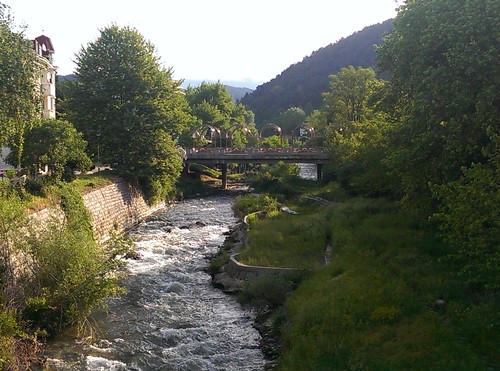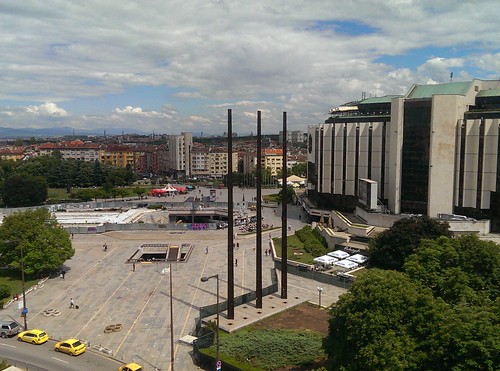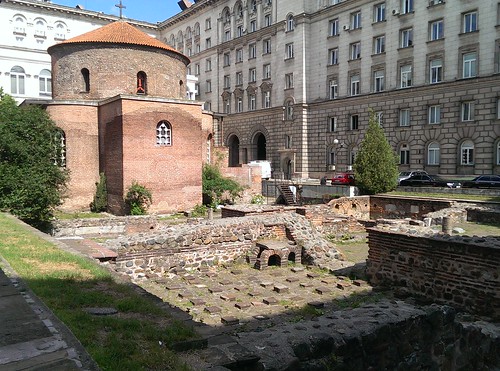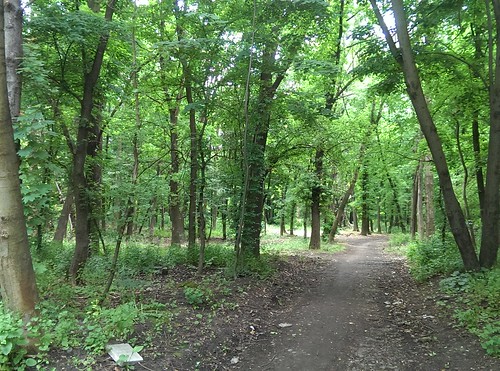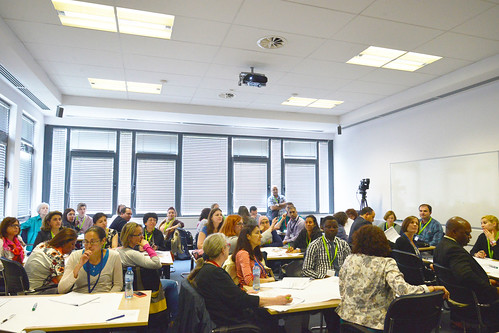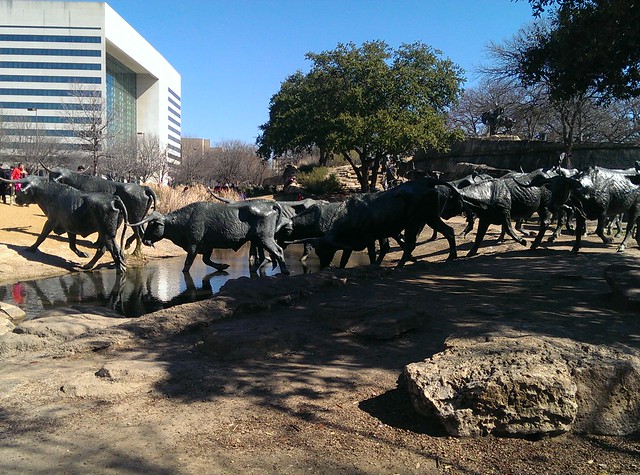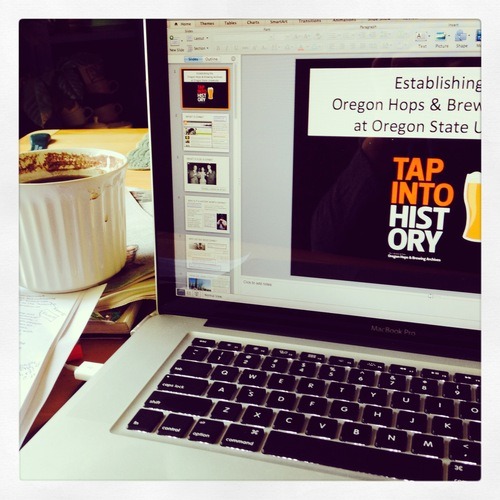Overarching takeaways:
- I was definitely not the target audience for this conference, both because I was from the US and also because of the types of learning spaces we focus on in the library. That was both a strength and a challenge for me. Hearing about what people are doing in another context is usually a great way to think about issues form a new direction, and this was definitely true for me here. On the other hand, there were a LOT of presentations that were essentially infomercials for architects. This was particularly frustrating because architectural firms generally do research that would be useful, but with one exception, these didn’t report on that.
- I also learned that in the UK, space planning/facilities work is referred to as “Estates” which comes across as Very Fancy. As in “the Engineering Estates are looking a little shabby.” The campus is the “Estates,” a unit or department’s buildings are referred to as the “Engineering (or Psychology, or Sciences) Estates” and so on.
1.
The opening talk was from Marij Vaugelers from the University of Amsterdam and she was clearly charged with giving a “state of the field” talk. She relied heavily on documents from Educause and Gartner, though she also pointed to this report out of the UK which might be of interest: https://www.ucisa.ac.uk/learningspace.
Looking at the change curve – she positioned learning space talk here, which felt kind of accurate to me – after the honeymoon and trough of despair.
Overall, the talk felt to me like it could have been given at any point in the last 10 years, but given how heavily she relied on US sources, I think that might just be a reflection of the relative state(s) of this field. She was reporting on what was going on in the US for a fair part of the talk, so of course that was more familiar to me.
2.
Eleanor Magennis from U. Glasgow gave one of my favorite talks at the conference.
(Basically, the talks that were about people’s own work were the best – the “tour of cool” talks running through a bunch of pictures of other people’s work were less so. And the talks where someone talked about their own work and focused on WHY they did what they did – what specific problems they were trying to solve, and what data they used — were by far the best. Increasingly, I am of the opinion that learning spaces need to be pretty deeply situated in context — I’m not just ever going to want to replicate someone else’s space they built for their community. So the more someone tells me about how they responded to their context, the more useful their talk is. This was one of those.)
Eleanor works on learning space design for her whole campus (and is also part of the planning committee for the toolkit linked above) and the University of Glasgow is currently working to bring a new “learning hub” space online, but this talk focused on 2-3 specific rooms that are already in use. Glasgow sounded like a spot that might be good for a site visit, if the opportunity arose.
Takeaways:
- Glasgow has a campus-wide “teaching/learning showcase” event every year that is attended by many of the teaching faculty and some students. The Estates group piggybacked off this event, to gather user feedback and input. They created a “showcase” room where they brought in furniture, set up a room and gathered feedback. We don’t really have a similar event here (University Day, maybe?) but it seems like a good idea to keep in mind.
- They create these “fact sheets” for all new classrooms and learning spaces – this seems like a really good idea:

- This was by far the best takeaway from the talk. They do a lot of data gathering and post-implementation assessment (this is one reason I thought they’d be a good space for a site visit – to get info on how they do this). She said the had hoped that they would find some clear directions from this data, but what they found was there is no clear best option. Different people need different spaces at different times and for different purposes, so the best option is to offer lots of variety.
- Some of the best results for feedback come from paper postcards/drop boxes in the new spaces:
3.
Louise Naylor from the University of Kent in Canterbury. This was by far my favorite talk of the conference and another location I think would be worthwhile for a site visit. Louise oversees 4 teaching and learning related units at Kent, including learning spaces, CTL type stuff, and assessment. She is also working on a major learning spaces project, but chose to focus this talk on something else – student collaborations.
The talk was great because 1. The student collaborations were aligned with things we’ve talked about doing, and 2. She spent a lot of time talking about informal and outdoor (!) spaces.
- Kent has an articulated Education and Student Experience strategy (PDF) that values both the curricular and co-curricular learning, and which argues that education and student life need to be considered together. So learning space development considered both of those things.
- The first thing she described was the Social Hubs Research project where anthropology students did investigative work to support learning space development.
- They looked at usage of a variety of campus learning spaces to understand the broader learning culture of the institution as well as how specific spaces were used.
- The methodology was developed in a graduate course, but implemented outside the classroom – many students worked on it, some as paid jobs.
- Again, a primary finding of the research was that when it comes to learning spaces, one size does not fit all.
- I talked to Louise about this project quite a bit, and she is going to connect me to the project leaders.
- Creative Campus Projects:
- The Create Café:
- One problem to be solved (that is always super relevant in libraries): underutilized walkways and corridors:
- Ran a student competition to redesign an ugly corridor that happened to be located in the ARCH school. The winning designer got an internship with a local architecture firm to make the project happen.
- A café that can also be transformed into a seminar space OR a performance space.
- Windows are also sliding doors to create an indoor/outdoor space (Note – this is a repeating theme).
- Walkway that became student gallery space. Initially, it was used to showcase student art projects, but now has shown architecture projects and art by little kids.
- Outdoor seating and game space outside the library, informed by Social Hubs research.
- Student-created outdoor classroom from salvaged wood. Bookable on the university timetable.
- Another = integrating wellness & learning. Canterbury Labyrinth:
- The Create Café:
There’s a chapter in this book about the space development process: Dunne, E., & Owen, Derfel. (2013). The student engagement handbook : Practice in higher education (First ed.). United Kingdom: Emerald: http://search.library.oregonstate.edu/OSU:everything:CP71194486610001451
4.
This was co-presented by an academic (Engineer Peter Green) and an architect (Fedele Canosa), who collaborated to build a new building at the University of Manchester. The title was “an academic’s journey thorough leading a major project: The Manchester Engineering Campus Project. Having both of them there elevated this beyond an architect’s infomercial and pushed the focus to why they made the choices they did.
- Key question: How do you brief your architect/ what does the architect need to know? They distilled this down to a key question, one that I think is useful for us, too: What is special about teaching in this space? This pushed faculty away from the “what spaces to we need” to “what do we want to do.”
- Faculty were also much better able to talk about potential spaces with visuals – with a draft design and model they could talk more effectively about what they needed, but also talk more effectively about how they could change teaching and learning in an new space. In other words, on their own, they had a hard time breaking out of the “lecture theater” mode. When they had designs to respond to, they could start thinking more in terms of multifunctional spaces.
- They recommend thinking about:
- First, behavior – what are users allowed to DO in this space?
- Then, space – what physical and design elements will communicate or inspire that behavior.
- And finally, how can we make the plans flexible, for when the future looks different than we’re predicting now.
- Specifics about their space that I thought were interesting for us:
- Big emphasis on opening up the teaching to the community. They’re not a land grant, of course, but there was a similar emphasis on breaking down walls between the institution and the community. So they put in glass walls – kind of like in the Pauling Center.
- This was culturally challenging – some faculty really, really don’t want to teach “in public”
- But this was cool – they’re envisioning “lunch and learns” where people can sit in on the edges of EXISTING COURSES. This is actually already happening.
- They had this big space that was used to move people from point A to point B for part of the day. But it was kind of a problem space – huge real estate, that couldn’t really be carved up. So they solved the problem by creating this massive staircase. Because with that, instead of just a conduit it can also double as an event space:
- Big emphasis on opening up the teaching to the community. They’re not a land grant, of course, but there was a similar emphasis on breaking down walls between the institution and the community. So they put in glass walls – kind of like in the Pauling Center.
Obviously, we’re probably not going to create a huge staircase in the library for event space — what was relatable was the desire to create spaces that were multipurpose — this is a conduit to move people from A to B, but it can be easily configured into many different spaces and uses. And specifically, the need for event space is, I think, frequently overlooked. That huge staircase doubles as informal seating. There’s a glass wall that opens to the outside (and indoor-outdoor spaces were a recurring theme throughout the better talks). The space below can handle parties, poster sessions, lunch and learns and conferences, and it also connects directly to workshop space.
5.
Ulrike Thomas and Pam Woolner from Newcastle talked about workshops they did with teaching faculty in advance of designing spaces. This was another good talk and another one where the speakers are open to sharing some of their activities with us.
The researchers here came out of K-12, but were put in charge of a campus project to build a new classroom space. The problem they were trying to solve was to create a space that would support active learning, in many disciplines, in large (100+) classes.
Diamond Pattern Activity
Give users/faculty a set of 9 images. Tell them to work in groups to arrange those images in a diamond pattern. In our case, we were to answer the question “what is the best and worse higher education spaces.” This was way too broad. But you get the idea.
Once the groups arrange the images, then you get people talking across groups about why they put different images where they did.
After this initial workshop, they created a Working Party User Group who came together to make decisions along the way.
So, if it had all been like these talks, the conference would have been awesome. But unfortunately, these were all of my favorite talks. That said, I did have some additional takeaways:
A.
Keith Lilley from the University of Sheffield, talked about a 81 million pound building project: The Diamond at the University of Sheffield:
This talk raised more questions than answers for me, but some of the questions where interesting:
FIRST – he talked about an intentional choice to keep all faculty space out — including offices. So it is i just classrooms and informal learning spaces. The faculty offices are in another building across the quad.
SECOND, he talked about this as a super-popular study space on campus. In fact, he called it the most popular study space on campus (though I don’t know what data that is based upon) . He also said that this space was heavily used by all students — not just engineers.
WHICH MADE ME WONDER — are those things related. I have a hard time seeing a building owned by Engineering on this campus feel as if it was owned by all students. Was the decision to keep faculty offices out connected to this feeling open and welcoming to all students?
AND ALSO MADE ME WONDER — this didn’t really feel and wasn’t described as an “anything goes” space. The different learning areas within the building felt pretty controlled and locked down. So how does that connect to students having a sense of belonging?
ALSO. THERE IS A LIBRARY IN THE SPACE. This was super interesting. It’s about 20K volumes, a core, multidisciplinary collection, and it’s non-circulating (though students can return books borrowed from other campus libraries there. It is a library, not a separate-from-the-library-collection-of-books). He described the library within the Diamond as “The most popular study space on campus.” Healso said later that The Diamond’s opening did not affect usage in two other heavily used libraries: the Info Commons and the more traditional library (sounded to me like an Odegaard/Suzallo type deal). Their numbers haven’t gone down, but have even gone up. They are interpreting this to mean that more students are choosing to study on campus as they provide more options.
So this raises a super future question about our stuff elsewhere on campus, and also raises a question about what kinds of things signify workspace to students — more on this below.
B.
Mat Davies from the Said Business School at Oxford talked about two building-renovation projects. Neither one of them was super relevant to us (though they did have some recurring themes — indoor/outdoor spaces, multifunction spaces, public workshop space)
He also said they LOVE site visits.
What was interesting here, was the intersection between the two projects he highlighted.
FIRST – A new executive education center. And not just any Exec Ed center. This is for the customized training programmes that super rich companies contract with Oxford to do. So, not sending your middle managers to Oxford for training, but having Oxford set up a bespoke program just for your people. In other words, of all of the audiences for a Fancy Oxford Business education, this audience was the Most Fancy. So a huge part of this project was making sure that the space itself was the Most Fancy. That meant super fancy finishing, a great location at the center of campus, and the like. There were some other interesting things – like these were week=long immersive programs, so all of the spaces, including the cocktail party spaces had to have educational outcomes attached. But the main thing for our purposes here is that this space had to be Fancy. Only the Best.
SECOND = an Entrepreneurship Center. This was put into an old Foundry building. Again, some interesting things – this was not so much as classroom as experiential space so most of the building was a huge, open “co-working” space in the middle with a flexible space at one end that could be turned into a performance or workshop space.
But for our purposes, the interesting thing here is that the design and décor was intentionally Not Fancy. It was entirely furnished with repurposed furniture and finishings. In fact, they used salvaged paneling from another building that they literally got out of the dumpster. In other words, it was intentionally designed to look DIY because that was the work they wanted to encourage in the space.
So my question here is – what design elements should we put in the studio to encourage the work that we want people to do there. What signifies authorship, creativity, serious work? I am wondering if we shouldn’t think about putting books in the space – I think books might signify that kind of work to people, even if they aren’t actively using them? There is a reason people like to study in the stacks or sit in the reading collection space? Are there ways we can use technology to display the kind of creative or productive work we expect students to do in the space?
C.
The most interesting thing for our purposes from Mark Brown from Dublin City University’s talk was an interesting bit with metaphors that might be interesting to talk about – different metaphors for learning spaces (habitat/home; cave, campfire, mountaintop, watering hole) and how different spaces should reflect different metaphors. Thinking with users about what metaphors resonate might be an interesting info gathering method.
This talk got me thinking about OSU – probably because it’s not Dublin City University and DCU is what the talk was mostly about – but I wonder if there is a way to connect what we’re doing with OSU. I’m not sure “studio” works super well with our users (or maybe it does – maybe that’s a broader term than I’m thinking about). But is there a way to get at what our students think is special about OSU and bake that into the name, or the design of the space?







